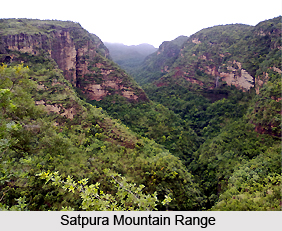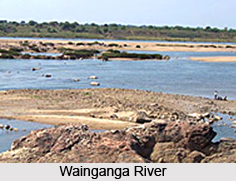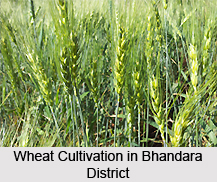 The topography of Bhandara district can be divided into two parts- the hilly tracts and the lowlands. There are a number of hill ranges found in the district of Bhandara. The lowest and most northerly of these hill ranges is the Ambagad range. It is on the extreme outlier of the Satpura mountain range running in the extreme north-west of the district area to the north and west of the Wainganga River. It separates the valley of the Bawanthari River from that of the Wainganga. There is wide gap, with a width of about 3 km. wide in the Ambagad range, just east of the spur of the Ambagad fort; it is drained by the Amabagad nadi, and is used by the Tumsar Katangi road and railway.
The topography of Bhandara district can be divided into two parts- the hilly tracts and the lowlands. There are a number of hill ranges found in the district of Bhandara. The lowest and most northerly of these hill ranges is the Ambagad range. It is on the extreme outlier of the Satpura mountain range running in the extreme north-west of the district area to the north and west of the Wainganga River. It separates the valley of the Bawanthari River from that of the Wainganga. There is wide gap, with a width of about 3 km. wide in the Ambagad range, just east of the spur of the Ambagad fort; it is drained by the Amabagad nadi, and is used by the Tumsar Katangi road and railway.
About 9km south-west of Bhandara town, there lie two isolated hill ranges, each about 5 km long in a south-west-north-east direction and about 2 km wide; these hills together may be termed as the Ballahi range. These hills, rising about 150m above the valley floor, overhang the Great Eastern Highway on either side and form prominent features of the landscape that can be seen for quite some distance along the road. These hills are underlain by sandstones, quartzites and granulites. Just west of the Wainganga river and the township of Pauni in the south western extremes of the district are a clump of hills called the Gaidongri and Nishti hills rising to about 300 km. above sea-level, and barely 50 to 100 m. above the adjoining plains.
The lowlands of Bhandara district lie mainly along the valley of the river Wainganga, Bagh, Chullband and Bawanthari, and the most extensive of them occur along the first two rivers. The other two river valleys have a rolling topography dotted with a number of residual hills.
The soils of the district are varied, arising out of the tropical sub-humid weathering of crystalline metamorphic and igneous rocks. They are essentially residual, though along the southern extremes of the Wainganga valley, downstream of Pauni, alluvial soil predominates. Kali or black Regur soil derived from the weathering of basaltsis generally rare in the district. Kanhar or very rich alluvial soils occur widely. These soils crumble readily and are easy to work. They are clay loams in texture, very deep, sticky and retentive of moisture; they bear double crops.  Morand soils are coarser in texture and occur farther away from the rivers, in relatively higher ground in comparison to the Kanhar soils. They generally have an admixture of sands or lime or both. The Khardi soils are dark in colour with a considerable admixture of lime; they are generally shallow. They are poor soils. The sihar is a reddish yellow soil derived from crystalline rocks as a result of oxidation under tropical humid conditions and cracks very little in the hot weather. It degrades into the khardi.
Morand soils are coarser in texture and occur farther away from the rivers, in relatively higher ground in comparison to the Kanhar soils. They generally have an admixture of sands or lime or both. The Khardi soils are dark in colour with a considerable admixture of lime; they are generally shallow. They are poor soils. The sihar is a reddish yellow soil derived from crystalline rocks as a result of oxidation under tropical humid conditions and cracks very little in the hot weather. It degrades into the khardi.
Most of the cultivable soils of the district belong to the morand and sihar types, both of which are light and slightly acidic. The sihar are the best rice soils of the district while the morand soils are devoted to rabi crops like wheat and linseed and kharif jowar. Poor lateritic bardi soils are found in foothills and sloping areas. Along the immediate banks of rivers, black kachhar soils, reddish and sandy marhani soils, and sandy retari soils are found; these soils are mostly immature. The marhani soils are devoted to garden crops.
The entire district of Bhandara falls within the drainage of the Wainganga River and one of its principle affluent, the Bagh. The source streams of the Wainganga rise in the Chhindwara and Seoni plateaus of Madhya Pradesh. The river flows south through the Balaghat district before entering Bhandara district at its northern extreme. It initially flows west along the northern boundary, then turns south-west and gradually southwards through the Bhandara tahsil. Before leaving the district to enter Chandrapur, the river runs south-east. Thus, the Wainganga drains mainly the western parts of the district. The Bawanthadi River rises in the Kurai plateau of Seoni district (Madhya Pradesh) flows south, enters the district at the north-western limit of the boundary, and runs east forming the northern boundary for a distance of 48 kms before falling into the Wainganga. Through small and seasonal in its upper course, the river after entering this district is fed by numerous hill torrents and is perennial. It drains the north-western parts of the district around Ambagad and Chandrapur. The river has low banks and hence, in floods, overflows the banks. Quicksand occurs in many parts of the river bed. The Ambagad nadi rises in the foothills to the north of the Ambagad range, flows south through a wide breach in the Ambagad hills to join the Wainganga on its right bank east of Tumsar. The Bodalkasa nadi drains the overflow of the Bodalkasa tank westwards to join the Wainganga on its left bank just downstream of the confluence of the Ambagad nadi. Just before its confluence with the main stream, it is met by an affluent, the Chorkhamara nadi draining the overflow of the Chorkhamara tank. The Garhvi nadi, also known as the Itiadoh nadi, rises in the granitic plateau of Chichgarh in the south-eastern part of Sakoli tahsil and flows west in a deep and narrow valley. As it flows past the village Palasgaon, the Valley opens out, but about 15 km downstream, it cuts through a quartzite spur of the Nawegaon hills in a deep gorge; the panorama from the Pratapgad fort eastwards as the river rushes out from the gorge is a pleasant sight to watch. The river continues further south, opening out into a wide valley with shallow banks to enter into the Chandrapur district before joining the Wainganga. The river has a flow of 60 km. through this district.
The river has low banks and hence, in floods, overflows the banks. Quicksand occurs in many parts of the river bed. The Ambagad nadi rises in the foothills to the north of the Ambagad range, flows south through a wide breach in the Ambagad hills to join the Wainganga on its right bank east of Tumsar. The Bodalkasa nadi drains the overflow of the Bodalkasa tank westwards to join the Wainganga on its left bank just downstream of the confluence of the Ambagad nadi. Just before its confluence with the main stream, it is met by an affluent, the Chorkhamara nadi draining the overflow of the Chorkhamara tank. The Garhvi nadi, also known as the Itiadoh nadi, rises in the granitic plateau of Chichgarh in the south-eastern part of Sakoli tahsil and flows west in a deep and narrow valley. As it flows past the village Palasgaon, the Valley opens out, but about 15 km downstream, it cuts through a quartzite spur of the Nawegaon hills in a deep gorge; the panorama from the Pratapgad fort eastwards as the river rushes out from the gorge is a pleasant sight to watch. The river continues further south, opening out into a wide valley with shallow banks to enter into the Chandrapur district before joining the Wainganga. The river has a flow of 60 km. through this district.
The average annual rainfall in the district is 1,470.6 mm (57-89). The rain fall generally increases from the west towards the east. It varies from 1312.9 mm (51-69) at Chandpur near the western border of the district to 1578-5 mm (62-15) at Gondia near the north eastern border of the district. The south-west monsoon arrives over the district by about the second week of June. The rainfall during the period from June to September constitutes about 90 percent of the annual normal rainfall. July and August are the months with heaviest rainfall, July being the rainiest month. The variation in the annual rainfall from year to year is small.






